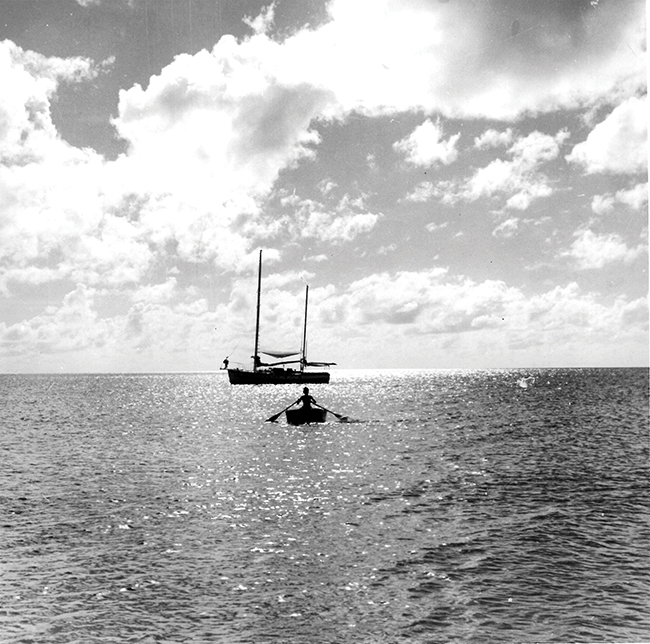Part One: Looking back at a family cruise that took them straight into the Cuban revolution (published March 2018)
Flying fish and flying spray were keeping my dad from lighting the cigarette he so fervently desired.
“Nils Jr., can you please pass me up a lit cigarette?” he yelled down the main hatch of our 1938, 33-foot Hereshoff ketch Winds Way IV. We were attempting a rough Gulf Stream crossing from Key West, Florida to Varadero, Cuba in the revolutionary summer of 1958, and everyone was seasick except Dad; but poor brother Nils still had to light Dad’s cigs for him.
It turns out, we got to Havana before Fidel did, although his shadow would fall on us frequently during our three months cruising the North Coast of Cuba, “The Pearl of the Antilles”, as a family of five. Before there was Outward Bound or other adventurous team building activities common today, we created our own adventure on our little wooden sailboat that only had four bunks.
We were our mother, Dorothy, who was such a good sport, father Nils, I was eight and a half, my brother (and our first mate) Nils Jr. was 15 and our baby sister, Cynthia, who was almost two and a half. We were not a very imposing bunch and certainly not a revolutionary force (as we would later be suspected of in both Cuba and Haiti!)
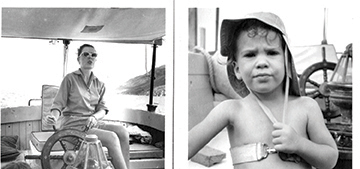
I guess we were well ahead of our time as a family cruising on a small sailboat, which in those days, was a very rare occurrence; but then my father Nils K. Florman had always been somewhat of an adventurous chap, usually marching to the beat of his own independent drum. When he was a young man, he had sailed with the famous Count Von Luckner, the German “Sea Wolf”, who ran a training ship on his Seadler between the Wars.
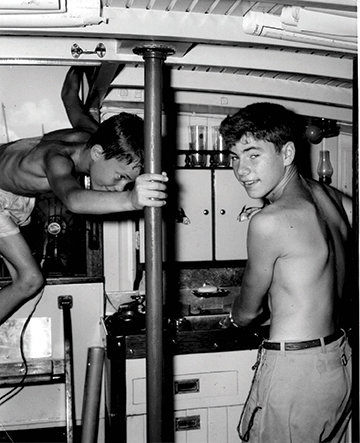
Dad had done some writing for Yachting, The Rudder and other boating magazines in 1957 and 1958, so while we were in Cuba various political types came to talk to the “American Journalist”, usually at night. That and the novelty of a young family cruising on a small wooden sailboat provided us with access and introductions to a wide variety of the friendly, curious and very hospitable Cuban people we met along the way. Everywhere we went, we were invited into people’s homes to eat, shower, or socialize (which was of special interest to teen brother, Nils Jr.).
A great deal of the conversation at that time was about the budding revolution and the pros and cons of Fulgencio Batista versus Fidel Castro. Many of the Cuban people we met wanted to believe that Castro would improve their lot and that of the country. We didn’t know then how that was going to turn out, although many people had their suspicions.
We met a lot of helpful and interesting people while we were in Varadero, including a justice of the Cuban Supreme Court, who was also a cruising boater. He generously spent hours dictating notes from his cruising experiences along the Cuban coast as the charts we had were old and had not been updated in many years.
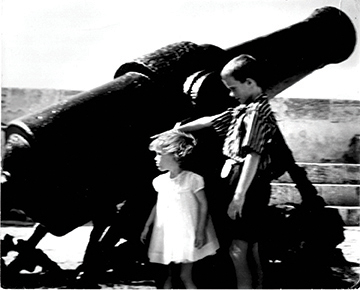
We had a very pleasant stay in Varadero, consuming fresh fruit and ice cream sold on the beautiful beaches and riding on the gua guas (the happy, funky, Cuban buses). We made the obligatory trip to Havana’s Morro Castle and visited the El Floridita bar of Hemingway fame. Soon, we continued our journey down the Cuban coast. If we could have foreseen some of the challenges and wild experiences that lay ahead, we might have had second, more cautious thoughts.
After all, hadn’t my Mom and Dad’s friends all told them that they were crazy to even consider making such a dangerous journey (and with two and a half and eight and a half year old children no less). But then we would have missed all the incredible, life enriching experiences that to this day have influenced our lives in so many positive and beneficial ways. I doubt there is anyone who has cruised on a boat, especially a sailboat, with a family or a group of other people who doesn’t feel that the experience contributed richly to their entire life experience. It certainly was an incredible bonding experience for us that created a wonderful closeness in our family that exists to this day.
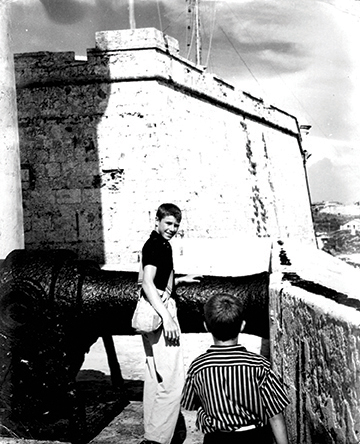
Heading east from Varadero, we encountered the Jardines del Rey archipelago, (as it now known,) a series of bays and barrier islands, not unlike parts of Florida’s two coasts. It was here, cruising through this beautiful, completely unspoiled, tropical scenery that we became immersed in the mysterious and exotic essence of the island and her people as it was then.
Cruising inshore of these barrier islands through an unmarked passage of mostly shallow waters and sandbars, we experienced our first grounding near Bahia Santa Clara. Wind’s Way drew less than four feet but we managed to find a sandbar that offered less than that. We were befriended by a passing motor yacht that attempted, rather clumsily, to pull us off. After securing our tow line to their stern cleat from our stern cleat, they then took off at full speed until they came to the end of the slack in the tow line at which time they became quickly acquainted with Newton’s Second Law of Motion; the stern cleat pulled out of their “unstoppable force” and almost decapitated Nils Jr. on the stern of the (for now) “immoveable object”. Nils and Dad had just enough time to jump forward into the cockpit, but despite all that brute force pulling, our boat budged not an inch.
The tow lines were now permanently joined together with a square knot that we were never able to undo, owing to the incredible force that had been applied. The motor yacht owner, a brave and kind man, still wanted to help us, so after some brief consultation, he tried again and was able to pull us off stern first, from the sandbar.
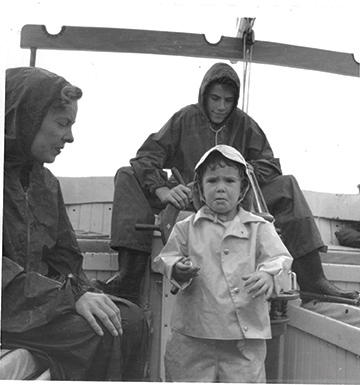
Later, as we made our way down the coast, we experienced another grounding; the resolution of which was remarkable. We were sitting there on a sandbar unable to get off with our Graymarine gasoline engine alone, when along came a Cuban sailor, a carbonero by trade (a maker and vendor of charcoal), who used his 30-foot, very simple gaff rigged sailboat, with sails made of flour sacks sewn together, to make his living transporting the charcoal that he sold. This incredible seaman stopped to offer his help.
We felt there wasn’t much that he would be able to do with sail power only on his little boat, but having no other options, we were certainly willing to try and we watched in amazement as this man skillfully dashed back and forth raising and lowering his sail and succeeding in helping us get off of that sandbar.
My father tried to compensate him with money but this proud man refused. Dad then ran down into the cabin and came back with a half bottle of rum and couple of Cuban cigars. This man, who could have easily been mistaken for the hero of The Old Man and the Sea accepted the rum and cigars saying, “These I will take for they are good for the soul!”
Continuing down the coast we began having problems with our generator so we put into what would be the largest port we stopped in along the coast of Cuba, Puerto Sagua La Grande. There we were referred to three gentlemen who were electricians and mechanics. These three fellows were like all the Cubans we met along the way, very friendly and eager to help us any way they could.
The problem with our generator required the commutator to be rewound and these ingenious mechanic friends hand wound the commutator and got it to work. They too, would not accept any payment, but expressed a desire to be transported along with a few family members on our boat, to a nearby island where they were going to pass a short holiday.
We had a very interesting encounter with them as my dad and mom got into a political discussion on the topic of the day which was “Is Castro a communist or is he not?” After this had been discussed for a while one of the gentlemen ended the conversation by saying to us, “Senor, if Castro is a communist then you are speaking to three communists as well”.
Politics was decidedly the major background theme during our time in Cuba. It seemed that almost all of the people we met were tired of the Batista regime but many were also apprehensive about Castro. The Batista government saw us as potentially being aides or allies of the Castro uprising and so they kept tabs on us throughout our journey down the coast. We were frequently flown over by military aircraft, at one time overhearing a lighthouse keeper asking a military plane about the whereabouts of the Lancha Americana on the AM radio. (Our radio, in those days, was one of the old double sideband AM radios).
We were also shadowed at various times by people keeping an eye or spying on us. Humorously, one time my mom and dad, growing tired of being watched constantly, suggested I invite the spy of the moment out in our dinghy. It was an eight-foot Optimist Pram that my dad had purchased as a dinghy in order for me to have something to sail as well as being a tender. The very relaxed and friendly Cuban spy (we were on a first name basis) accepted my offer and we had a grand time rowing around the harbor for a couple of hours while mom and dad got a break.
After leaving Sagua La Grande with our newly repaired generator, our next notable experience on this voyage was sailing past a group of two large barrier islands marked on the chart as Cayo Romano. This passage was our only overnight passage along the coast and we must have been bucking a lot of tide and head seas because it seemed like we were abeam of the Cayo Romano light the whole night. It was a rough not fondly remembered night passage.
At our next stop east of Cayo Romano, we had been told about an interesting place called Cayo Lobos or Lobos Cay, which is a small Bahamian island with a lighthouse on the Bahamian side of the Old Bahama Channel. It is only 13 miles north of Cayo Confites, Cuba, so we ventured across the channel to have a look.
One of the more interesting places we visited on the cruise, Lobos Cay marks the north side of this narrow part of the Old Bahama Channel. It was inhabited by two Bahamian lighthouse keepers and their families. The Cuban people who had told us about this place described them as Ingleses De Colour or “Englishmen of Color”.) These warm congenial people were very happy to see us as they did not get a lot of visitors to this remote island. They shared their lives with us and showed us the little cemetery where a couple of family members had been buried and then, when, the island freighter Inagua Trader showed up one night to bring them their monthly supplies, they shared with us their ice, lettuce and fresh Holsum bread from Miami.
Not having had fresh bread like that in a while, we were glad to store the leftovers and we had a little midnight feast with our benefactors in the cabin of our little ship. The lighthouse keepers had a little dog that had been given to them by a Cuban fisherman that they had named “Amigo”. The following year when we were resettled in Fort Lauderdale our new dog was named “Migo” by sister Cynthia who remembered the little dog on Lobos Cay.
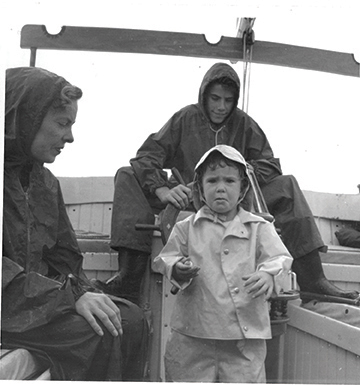
Another great memory was created at another island near Lobos Cay that we visited that was a seabird rookery. It was covered with seabirds of all kinds that seemingly had no fear of us humans and only grudgingly moved out of the way when we walked near them. (Nils still remembers the little hummingbird that sat in his hand and let him pet it.)
From here we only stopped briefly to rest overnight as we were trying to get to the eastern end of the island at Baracoa as soon as we could. Our last stop in Cuba, Baracoa, would turn out to be the most eventful by far. We had not noticed that the little yellow flag on our man overboard pole had come unfurled and was mistaken by the port doctor as a yellow quarantine flag.
So, the doctor came out to clear us in and we became friends, which was a very good thing as Hurricane Ella was headed our way and would strike Cuba on September 2, 1958. The harbor of Baracoa is a five-mile-long, nearly land locked harbor, which offers great protection. While anchored there, we were treated to flashes and sounds of gunfire up in the hills above the harbor which the good doctor told us were the Castro rebels fighting with Batista forces. Yikes!
Meanwhile, with Hurricane Ella heading our way the doctor invited my mother, sister and I, to come stay with his family in his house, while Dad and Nils Jr. rode out the storm attached to a ship’s mooring in the harbor. We were anxious to have the best weather information possible about the approaching storm, but our old double sideband radio was not capable of reaching Miami. Nils Jr., who was our radio operator, was overheard trying to raise Miami weather by the Alcoa Warrior, a ship hauling bauxite to somewhere in the U.S. Her radio operator overheard Nils and volunteered to provide us with weather bulletins the whole night.
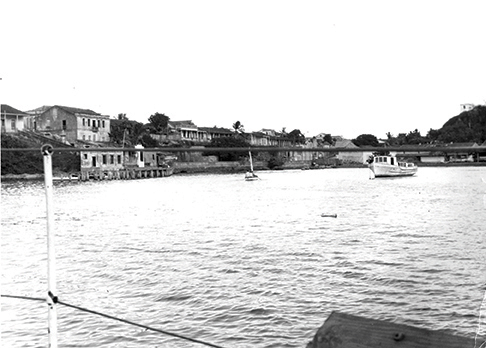
By the time Ella got to Baracoa she was only a Category 1 storm but still able to pack a pretty good punch. I remember, as we were leaving the boat to go ashore before the storm, being barely able to stand up and walk against the force of the wind. We, the boat and the town, survived just fine. When we left Baracoa, it was with fond memories of yet another group of good friends that we had made in Cuba. None of us have ever forgotten the friendliness and hospitality of the Cuban people, who took us into their hearts and their homes wherever we went.
In Part Two, next month, Wind’s Way sails across the Windward Passage to the island of Hispaniola, where Mark and his family visited Haiti and the Dominican Republic.
After this life-changing experience, it was inevitable that Mark Florman would become a yacht captain, and then a yacht broker. After 31 years owning Latitude 26° Yacht Sales, Mark joined Waterfront Properties and Waterfront Yacht Brokerage in Jupiter, FL, as a dual threat waterfront realtor and yacht broker. He dedicates this story with much love and respect to his two unique and adventurous parents, Nils and Dorothy Florman, without whom none of this would have happened.















